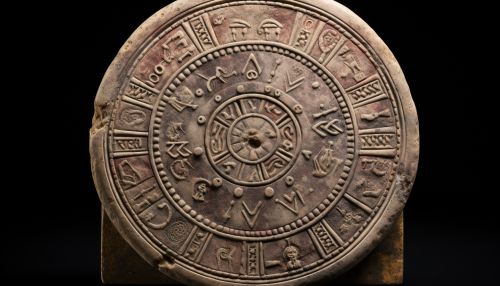Roman calendar
Origins and History
The Roman calendar, or "calendarium", was the time reckoning system used in ancient Rome from the founding of the city in 753 BC until 46 BC, when Julian calendar was introduced by Julius Caesar. The Roman calendar underwent several changes and reforms over the centuries, reflecting the city's transition from a small Latin settlement to the capital of a vast empire.
The earliest Roman calendar was a lunar calendar, based on the phases of the moon, and is thought to have been a direct borrowing from the Greeks or a common Indo-European source. This calendar consisted of 10 months, beginning in March (Martius) and ending in December (Decembris), with a winter period of approximately 61 days not assigned to any month. The months of January (Ianuarius) and February (Februarius) were later added to the beginning of the year during the reign of the second Roman king, Numa Pompilius, around 713 BC.


Structure and Elements
The Roman calendar was a complex system that included lunar, solar, and ritual elements. The basic unit of the calendar was the day (dies), which was divided into various parts for different purposes. The calendar also included weeks (septimana), months (mensis), and years (annus).
The Roman year was divided into 12 months, each of varying lengths. The months were: Ianuarius (31 days), Februarius (28 days in a common year and 23 or 24 in an intercalary year), Martius (31 days), Aprilis (30 days), Maius (31 days), Iunius (30 days), Quintilis or Iulius (31 days), Sextilis or Augustus (31 days), September (30 days), October (31 days), November (30 days), and December (31 days).
The Roman calendar also included a number of festivals and public holidays, many of which were specific to certain dates. These included the Saturnalia, a festival of Saturn held on December 17 and later expanded with festivities through December 23, and the Lupercalia, a festival of purification and fertility, held on February 15.
Intercalation
The Roman calendar was inherently flawed due to its lunar-solar nature. In order to keep the calendar year roughly aligned with the solar year, a month was occasionally inserted into the calendar. This month, known as the intercalary month (mensis intercalaris), was inserted after February 23 or 24, and the last five days of February were moved to the end of the intercalary month. The decision to insert an intercalary month was made by the pontifex maximus, the high priest of the College of Pontiffs in Rome, who had the authority to regulate the calendar.
Reforms
The Roman calendar underwent several reforms over the centuries. The most significant of these was the reform enacted by Julius Caesar in 46 BC. This reform, known as the Julian reform, created a solar calendar with months of fixed lengths and introduced the concept of the leap year. The Julian calendar remained in use in the Western world until it was replaced by the Gregorian calendar in 1582.
Legacy
The Roman calendar has left a significant legacy in the Western world. Many of the names of our modern months derive from the Roman calendar, and the Julian reform of the calendar laid the groundwork for the calendar system most widely used today.
